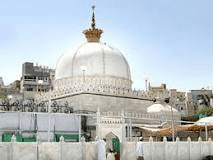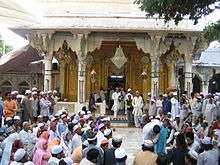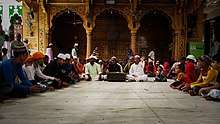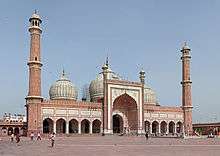Ajmer Sharif Dargah
Ajmer Sharif Dargah, Ajmer Dargah, Ajmer Sharif or Dargah Sharif[1][2] is a sufi shrine (dargah) of the revered sufi saint, Moinuddin Chishti, located at Ajmer, Rajasthan, India.[3] The shrine has Chisti's grave (Maqbara).[4]
| Ajmer Sharif Dargah | |
|---|---|
 The shrine of Moinuddin Chishti is one of India's most important Sufi shrines | |
| Religion | |
| Affiliation | Islam |
| District | Ajmer district |
| Province | Rajasthan |
| Ecclesiastical or organizational status | Shrine |
| Ownership | Government of Rajasthan |
| Location | |
| Location | Ajmer |
| Country | India |
 Shown within Rajasthan  Ajmer Sharif Dargah (India) | |
| Geographic coordinates | 26°27′22″N 74°37′41″E |
| Architecture | |
| Architect(s) | Sunni-Al-Jamaat |
| Type | Mosque, Sufi mausoleum |
| Style | Modern |
| Date established | 1236 (AD) |
| Completed | 1236 (AD) |
| Specifications | |
| Direction of façade | West |
| Dome(s) | 1 |
| Minaret(s) | 1 |
| Shrine(s) | 1 |
History
Moinuddin Chishti was a 13th-century sufi mystic saint and philosopher. Born in Sanjar (modern day Iran), or in Sijistan,[5] he travelled across South Asia, eventually settling in Ajmer (modern day Rajasthan, India), where he died in 1236.[6] The structure was expanded as local and national rulers came to pray here. In 1332, the Sultan of Delhi (Tughluq dynasty) Mohammad Bin Tughluq constructed a dargah (a commemoration structure constructed around the tomb of Muslim saints, where people from all religions come to pray and ask for favours) and it grew in popularity and size over the years.[7] The structure was subsequently expanded by a number of rulers including many saints.
Geography
Ajmer Sharif Dargah is 2 kilometres (1.2 mi) away from the main central Ajmer Railway station and 500 metres away from the Central Jail and is situated at the foot of the Taragarh hill. It consists of several white marble buildings arranged around two courtyards, including a massive gate known as Nizam Gate donated by the 7th Nizam of Hyderabad Mir Osman Ali Khan and the Akbari Mosque, built by the Mughal emperor Shah Jahan. It contains the domed tomb of the saint.
Gallery
 Dargah Sharif, Ajmer, 1893
Dargah Sharif, Ajmer, 1893- View of Dargah from outside
- The Way of Ajmer Dargah Sharif
 Dargah Main Gate, erected by Sultan Mahmood Khilji
Dargah Main Gate, erected by Sultan Mahmood Khilji Skyline View of Main Gate
Skyline View of Main Gate Dargah of Moinuddin Chishti
Dargah of Moinuddin Chishti Qawali at the front of Dargah
Qawali at the front of Dargah- The Beautiful Pillars of Dargah
- Rest Place of the Dargah
 The Dargah Sharif inside net gate
The Dargah Sharif inside net gate Inside view
Inside view The Former Prime Minister Manmohan Singh Handing over the 'Chadar' to Minister of State Prithviraj Chavan for Dargah since 2009
The Former Prime Minister Manmohan Singh Handing over the 'Chadar' to Minister of State Prithviraj Chavan for Dargah since 2009 The Former Prime Minister of India Manmohan Singh Handing Over the 'Chadar' to the Minister of State for Dargah
The Former Prime Minister of India Manmohan Singh Handing Over the 'Chadar' to the Minister of State for Dargah The Prime Minister Narendra Modi handing over the 'Chaadar' to be offered at Dargah of Khwaja Moinuddin Chishti,Ajmer Sharif, to the Minister of State for Minority Affairs and Parliamentary Affairs, Shri Mukhtar Abbas Naqvi, in New Delhi
The Prime Minister Narendra Modi handing over the 'Chaadar' to be offered at Dargah of Khwaja Moinuddin Chishti,Ajmer Sharif, to the Minister of State for Minority Affairs and Parliamentary Affairs, Shri Mukhtar Abbas Naqvi, in New Delhi Dargah Emblem
Dargah Emblem
Pilgrimage
Akbar and his queen used to come here by foot on pilgrimage from Agra every year in observance of a vow where he prayed for a son. The large pillars called "Kose ('Mile') Minar", erected at intervals of two miles (3 km) along the entire way between Agra and Ajmer mark the places where the royal pilgrims halted every day. It has been estimated that around 150,000 pilgrims visit the site every day.
The Shrine
The main gate to the shrine is the Nizam Gate, followed by the Shahjahani Gate, erected by the Mughal emperor Shah Jahan. In turn it is followed by the Buland Darwaza,[8] built by Sultan Mahmood Khilji,[9] upon which is hoisted the urs flag, marking the beginning of the death anniversary rituals.[10] The urs for Moinuddin Chishti is celebrated every year on the 6th and 7th of Rajab.[11]
Trust
The dargah (shrine) of Khwaja Moinuddin Chishti is an international waqf (endowment), managed under The Dargah Khwaja Saheb Act, 1955 of Government of India. The Dargah Committee, appointed by the Government, takes care of the maintenance of the shrine,[12] and runs charitable institutions like dispensaries, and guest houses for the devotees but do not care take the rituals of the main shrine (Mazar sharif/Astana e Alia) which is under the custody of hereditary priests known as Khadims.[13]
Dewan of the Dargah
Dewan Syed Zainul Abedin is the direct descendant in the 22nd generation of Khwaja Moinuddin Chishti. Meanwhile, according to the Supreme Court of India he is the Hereditary Sajjadanashin Spiritual Head of the shrine of Ajmer Dargah. On the other hand, in the aspect of genealogical lineage (family tree), presently he is the most direct descendant of Khawaja Moinuddin Chishti.[14] [15][16][17][18] He is the successor of Khwaja Gareeb Nawaz.[14][15][16][17][18] þ
Ajmer dargah blast case
On 11 October 2007, an explosion occurred in Dargah Khwaja Moinuddin Chishti's courtyard in Ajmer in Rajasthan. It was the holy fasting period of Ramazan and evening prayers had just ended. A crowd had gathered at the courtyard to break their fast. A bomb was placed inside a tiffin carrier went off. Reports said the blast claimed 7 lives and injured 17.[19][20]
Investigations
Special Judge Dinesh Gupta's nearly 500-page judgment was based on testimonies of 149 witnesses and 451 document submitted to his court.[19][20]
Criminals
On 22 March 2017, The National Investigation Agency (NIA) Special Court, sentenced two murderers named Bhavesh Patel and Davendra Gupta to life imprisonment, who were convicted for the 2007 Ajmer Dargah Blasts,[21] in which three people were killed.
Those convicted, Bhavesh Patel and Devendra Gupta,allegedly owed allegiance to Rashtriya Swayamsevak Sangh.[22] Both were held guilty under the Unlawful Activities Prevention Act, Explosives Act and various sections of Indian Penal Code.[19][20][22]
See also
- Shrine of Baba Farid
- Turabul Haq Dargah
- Dewan Syed Zainul Abedin
- Prophet's Day
- Baba Bhanderi
Notes and references
- "Muslims Should Observe World Yoga Day: Ajmer Sharif Dargah". Archived from the original on 18 June 2015. Retrieved 4 February 2018.
- Barack Obama offers 'chadar' at Ajmer Dargah Sharif for Chishty's 803rd Urs
- "Will carry on our work in India". Hindustan Times. Retrieved 18 February 2012.
- "797th Urs of Khawaja Moinuddin Chisty begins in Ajmer". Sify. Archived from the original on 1 October 2012. Retrieved 18 February 2012.
- Ashirbadi Lal Srivastava, Medieval Indian Culture (Jaipur: Siva Lal Agarwala Pub. 1964), p.80. Born in Sijistan about 1141.
- "Official website of Moinuddin Chishti". www.garibnawaz.net. Gharib Nawaz net. Retrieved 22 March 2019.
- See Andrew Rippin (ed.), The Blackwell Companion to the Quran (John Wiley & Sons, 2008), p. 357.
- This "high gate" or "buland darwaza" should not be confused with Akbar's more famous Buland Darwaza in Fatehpur Sikri.
- Sultan Mahmood Khilji II (Shihab-ud-Din Mahmud Shah II) ruled Malwa from 1510 to 1531.
- "Historical Monuments". Mission Sarkar Gharib Nawaz. Archived from the original on 29 January 2015.
- "Preparations for Urs in full swing at Ajmer dargah". The Times of India. 13 May 2011. Archived from the original on 26 May 2014.
- Ajmer sharif dargah Rajasthan
- Mayank Austen Soofi. "The Sufi Solution". Live Mint. Retrieved 18 February 2012.
- AIR6 1987. "Page: 2213". Supreme Court. Missing or empty
|url=(help) - AIR 1961. "Page: 1402". Supreme Court. Missing or empty
|url=(help) - AIR 1938. "Page: 71". Privy Council. Missing or empty
|url=(help) - AIR 1947. "Page: 01". Privy Council. Missing or empty
|url=(help) - RLW. "Page: 69 and 317". Rajasthan High Court. Missing or empty
|url=(help) - What is the Ajmer Dargah blast case? The Indian Express, March 22, 2017
- Ajmer Blast Case: NIA Court Awards Life Imprisonment to Devendra Gupta, Bhavesh Patel News 18, March 22, 2017
- Ajmer dargah blasts
- Bhavesh Patel and Devendra Gupta owed their allegiance to RSS in the past as per media trials. The Hindu, March 22, 2017
Further reading
- Currie, P. M. (1989). The shrine and cult of Muʻīn Al-Dīn Chishtī of Ajmer. Oxford University Press.
External links
- "Dargah Committee, Dargah Khwaja Saheb, Ajmer". gharibnawaz.in. Ministry of Minority Affairs, Government of India.
- "Ajmer Sharif Dargah, Shrine of Moinuddin Chishti, Ajmer". Rajasthan Department of Tourism.

